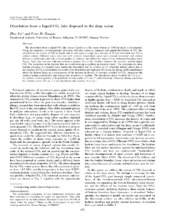Dissolution from a liquid CO2 lake disposed in the deep ocean
Peer reviewed, Journal article
Permanent lenke
https://hdl.handle.net/1956/390Utgivelsesdato
2003Metadata
Vis full innførselSamlinger
- Geophysical Institute [1198]
Sammendrag
The dissolution from a liquid CO2 lake source located at a flat ocean bottom at 3,000 m depth is investigated. Using the unsteady, two-dimensional advection–diffusion equation, temporal and spatial distribution of CO2 dissolved from the source of 500 m length and of unit span is sought in a domain of 20 km horizontal and 200 m vertical extent. Different cases were run with uniform longitudinal speed and constant horizontal and vertical diffusion coefficients and with vertical profiles of velocity and diffusivity derived from turbulent boundary layer theory. Each case was run with and without a hydrate film at the interface between the seawater and the liquid CO2. The properties of the hydrate film are modeled using a capillary permeation model. The computations show that the presence of a hydrate layer retards the dissolution rate by a factor of 2.7 when the density effects due to the increase of CO2 concentration as a result of the dissolution are neglected. However, the strong, stable stratification above the hydrate layer, as a consequence of the increase in density of seawater enriched by CO2, suppresses the vertical mixing considerably and reduces the sensitivity to hydrate. The dissolution rate is found to be 0.1 m yr-¹ for realistic vertical profiles of longitudinal velocity (order of 5 cm s-¹) and diffusivity. However, during conditions of a benthic storm (20 cm s-¹), the dissolution rate reaches 1.6 m yr-¹.
